Chapter 13: Cancer
How does cancer start?
How does cancer spread through the body?
What are the most common types of cancer?
How do I know if I have cancer?
The information in this chapter comes primarily from two Public Domain sources:
Chapter Learning Outcomes
By the end of this chapter you will be able to:
- Explain how cancer begins and spreads.
- Describe the difference between benign and malignant tumors.
- Compare incidence and risk factors for common types of cancer.
- Identify ways to prevent cancer.
The human body is composed of trillions of cells and every cell has a specific purpose. Cells provide structure for the body, take in nutrients from food, convert those nutrients into energy, and carry out specialized functions. When cells become damaged or die, the body makes new cells to replace them. For example, the epidermis of our skin continually makes new skin cells and we shed off old dead skin cells. Unfortunately, sometimes the cells in our body change and they begin to grow and divide when they shouldn’t, this is known as Cancer, all cancers begin with a change in just one microscopic cell.
Cancer is the 2nd leading cause of death in the U.S. after cardiovascular disease. In the United States in 2019, 1,752,735 new cancer cases were reported and 599,589 people died of cancer. For every 100,000 people, 439 new cancer cases were reported and 146 people died of cancer. In 2022 in the U.S., there will be an estimated 1,918,030 new cancer cases and 609,360 cancer deaths.
Cancer has a major impact on society in the United States and across the world. Thankfully, in the United States, the likelihood of dying from cancer has dropped steadily since the 1990s. Five-year survival rates for some cancers, such as breast, prostate, and thyroid cancers, now are 90 percent or better and the 5-year survival rate for all cancers combined is currently about 67 percent.
Understanding Cancer
Cancer can start almost anywhere in the human body, when just one of the trillions of cells changes and begins to grow uncontrollably and spread to other parts of the body. Normally, human cells grow and multiply (through a process called cell division) to form new cells as the body needs them. When cells grow old or become damaged, they are supposed to die and new cells take their place, however sometimes abnormal or damaged cells grow and multiply when they shouldn’t. These cells typically form tumors, which are lumps of tissue.
Normal Cells versus Cancer Cells
Cells group themselves together to make up the tissues and organs of our bodies and usually we have just the right number of each type of cell. This is because cells produce signals to control how much and how often the cells divide. For example, when the body is growing, such as from childhood to adulthood, the body will signal for more cells as the body tissues grow. Normal healthy cells also like each other, they know which other cells to join up with, and they stick together.
Normal cells:
- control their growth, reproducing when and where it’s needed.
- stick together and remain in their intended location in the body.
- die when they become damaged or too old to maintain homeostasis.
- become specialized with specific functions.
Cancer cells:
- grow in the absence of signals telling them to grow (normal cells only grow when they receive such signals).
- ignore signals that normally tell cells to stop dividing or to die .
- invade into nearby areas and spread to other areas of the body.
- tell blood vessels to grow toward tumors.
- hide from or trick the the immune system. The immune system normally eliminates damaged or abnormal cells. Cancers cells can trick the immune system into helping cancer cells stay alive and grow.
- accumulate multiple changes in their chromosomes, such as duplications and deletions of chromosome parts. Some cancer cells have double the normal number of chromosomes.
- rely on different kinds of nutrients than normal cells. In addition, some cancer cells make energy from nutrients in a different way than most normal cells. This lets cancer cells grow more quickly.
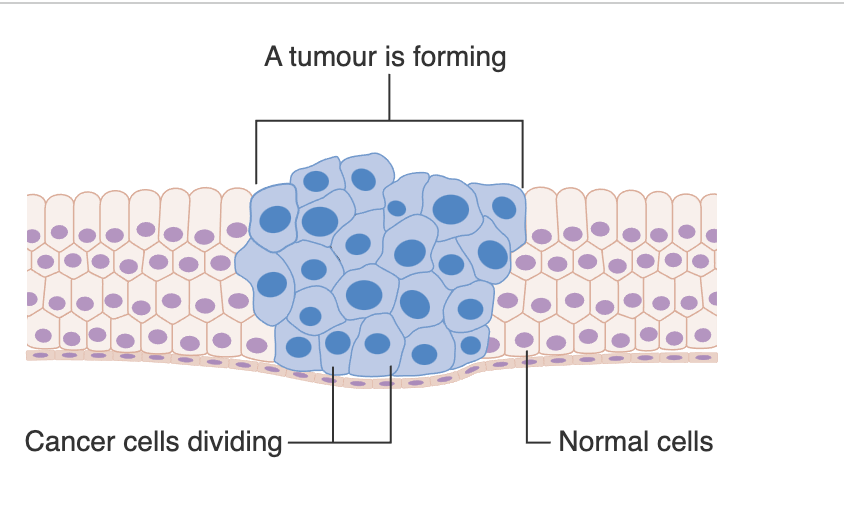
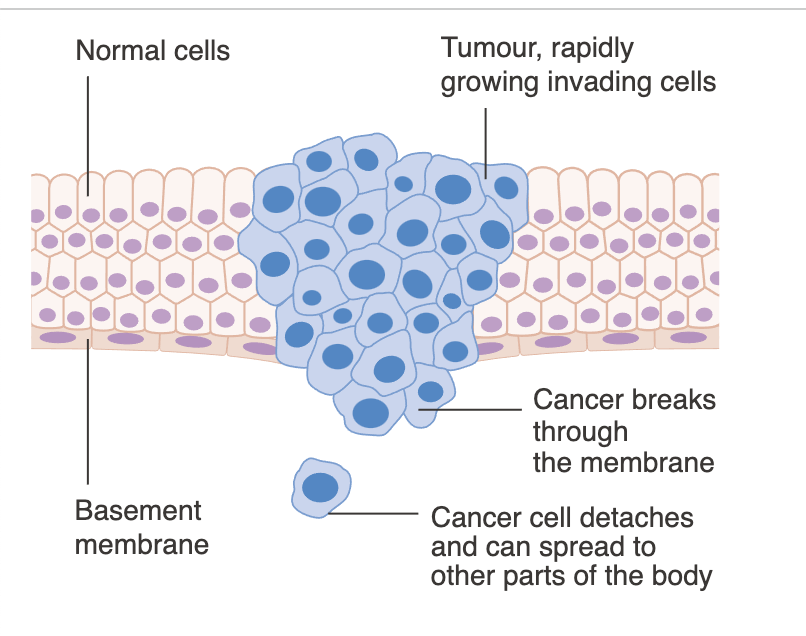
Benign versus Malignant Tumors
When cells grow and divide they may form tumors, which are a lump of tissue. These lumps might be benign or malignant. A benign tumor is not cancerous, a malignant tumor is cancerous. However, not all cancers form tumors, leukemia is a cancer of the blood cells that does not develop tumors, instead, the cancer cells build up in the blood and sometimes the bone marrow.
The big difference between a cancerous (malignant) tumor versus a non-cancerous (benign) tumor is the ability of the tumor to spread to other areas of the body, which is called metastasis. Benign tumors do not spread into, or invade, nearby tissues and are usually left in the body unless it is causing pain or is life threatening, such as benign tumors in the brain. Whereas, cancerous (malignant) tumors spread into, or invade, nearby tissues and can travel to distant places in the body to form new tumors.
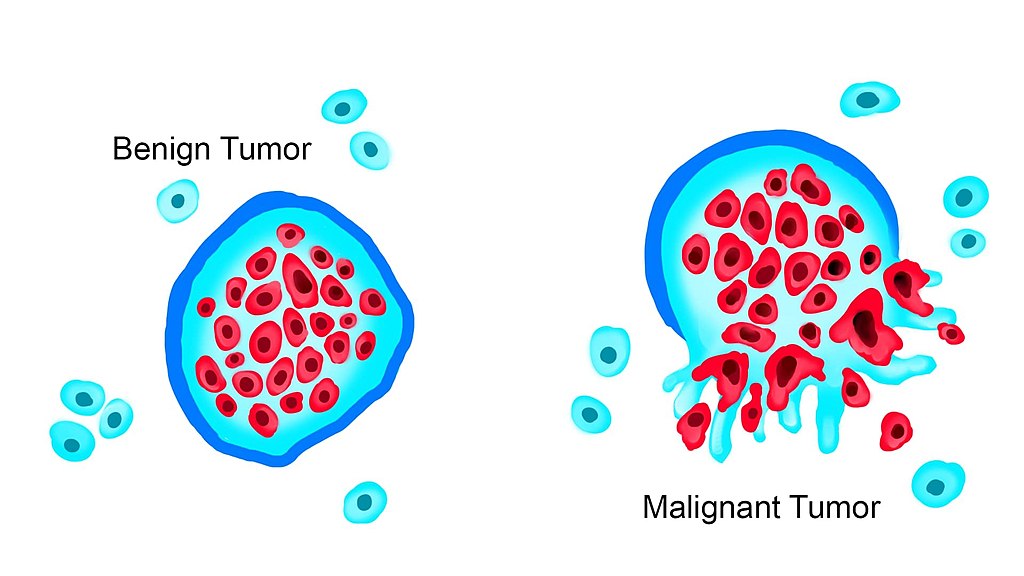
Benign tumors:
- usually grow quite slowly
- don’t spread to other parts of the body
- usually have a covering made up of normal cells
Malignant tumors:
- usually grow faster than benign tumors
- spread into surrounding tissues and cause damage
- may spread to other parts of the body in the bloodstream or through the lymph system to form secondary tumors. This is called metastasis
Metastasis
Cancer cells don’t like each other and do not stick together like normal cells. Rather, cancer cells leave their origin and spread to other parts of the body. The development of secondary malignant growths at a distance from a primary site of cancer is known as metastasis. When a cancer has spread to other parts of the body it is determined to be stage IV (4) cancer.
Cancer cells spread through the body in a series of steps:
- Grow into, or invade, nearby normal tissue.
- Move through the walls of nearby lymph nodes or blood vessels.
- Travel through the lymphatic system and bloodstream to other parts of the body.
- Stop in small blood vessels at a distant location, invading the blood vessel walls, and moving into the surrounding tissue.
- Grow in this tissue until a tiny tumor forms.
- Cause new blood vessels to grow, which creates a blood supply that allows the metastatic tumor to continue growing.
Cancer can metastasize to several places in the body, however it will be known by the primary site where the initial cancer cell began. For example, if a person has breast cancer that has spread to the lung, they will be determined to have stage IV breast cancer with lung metastases, not as lung cancer.
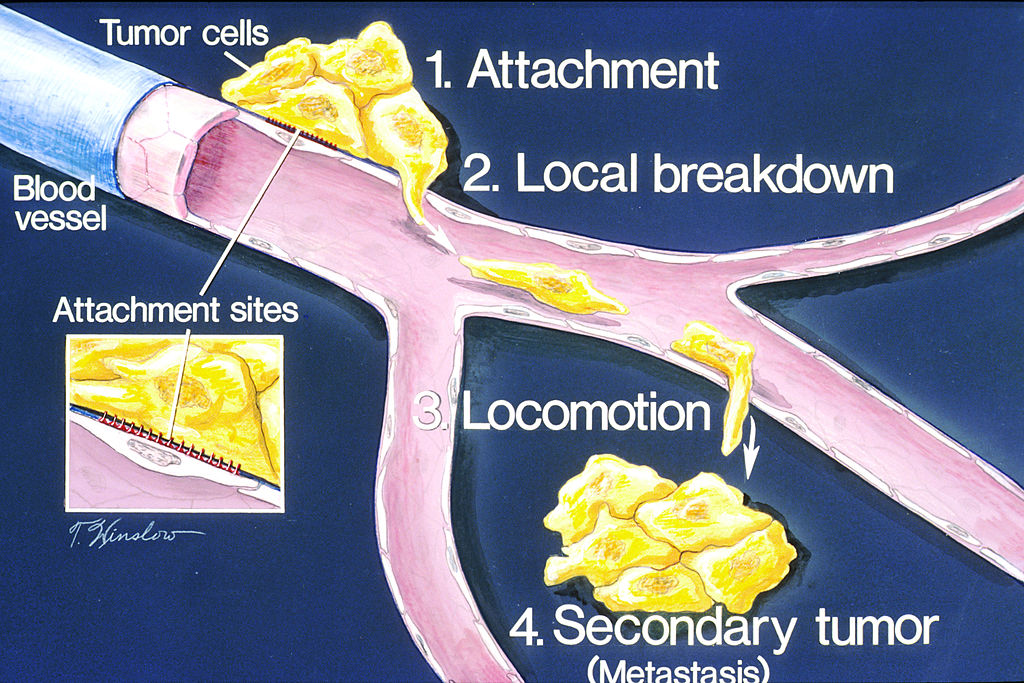
| Cancer Type | Main Sites of Metastasis or Secondary Tumors |
|---|---|
| Bladder | Bone, liver, lung |
| Breast | Bone, brain, liver, lung |
| Colon | Liver, lung, peritoneum |
| Kidney | Adrenal gland, bone, brain, liver, lung |
| Lung | Adrenal gland, bone, brain, liver, other lung |
| Melanoma | Bone, brain, liver, lung, skin, muscle |
| Ovary | Liver, lung, peritoneum |
| Pancreas | Liver, lung, peritoneum |
| Prostate | Adrenal gland, bone, liver, lung |
| Rectal | Liver, lung, peritoneum |
| Stomach | Liver, lung, peritoneum |
| Thyroid | Bone, liver, lung |
| Uterus | Bone, liver, lung, peritoneum, vagina |
Cancer Stages
The cancer stage refers to the extent of your cancer, such as how large the tumor is, and if it has spread.
A cancer is always referred to by the stage it was given at diagnosis, even if it gets worse or spreads. New information about how a cancer has changed over time gets added on to the original stage. So, the stage doesn’t change, even though the cancer might.
| Stage | What it means |
|---|---|
| Stage 0 | Abnormal cells are present but have not spread to nearby tissue. Also called carcinoma in situ, or CIS. CIS is not cancer, but it may become cancer. |
| Stage I, Stage II, and Stage III | Cancer is present. The higher the number, the larger the cancer tumor and the more it has spread into nearby tissues. |
| Stage IV | The cancer has spread to distant parts of the body. |
Types of Cancer
There are more than 100 types of cancer. Types of cancer are usually named for the organs or tissues where the cancers form. For example, lung cancer starts in the lung, and brain cancer starts in the brain. Cancers also may be described by the type of cell that formed them, such as an epithelial cell or a squamous cell.
Common categories of cancers that begin in specific types of cells include carcinomas, sarcomas, leukemias, lymphoma, myeloma, and melanoma.
- Carcinoma
- Carcinomas are the most common type of cancer. They are formed by epithelial cells, which are the cells that cover the inside and outside surfaces of the body.
- Sarcoma
- Sarcomas are cancers that form in bone and soft tissues, including muscle, fat, blood vessels, lymph vessels, and fibrous tissue (such as tendons and ligaments).
- Leukemia
- Cancers that begin in the blood-forming tissue of the bone marrow are called leukemias. These cancers do not form solid tumors. Instead, large numbers of abnormal white blood cells (leukemia cells and leukemic blast cells) build up in the blood and bone marrow, crowding out normal blood cells.
- Lymphoma
- Lymphoma is cancer that begins in lymphocytes (T cells or B cells). These are disease-fighting white blood cells that are part of the immune system. In lymphoma, abnormal lymphocytes build up in lymph nodes and lymph vessels, as well as in other organs of the body.
- Multiple Myeloma
- Multiple myeloma is cancer that begins in plasma cells, another type of immune cell. The abnormal plasma cells, called myeloma cells, build up in the bone marrow and form tumors in bones all through the body.
- Melanoma
- Melanoma is cancer that begins in cells that become melanocytes, which are specialized cells that make melanin (the pigment that gives skin its color). Most melanomas form on the skin, but melanomas can also form in other pigmented tissues, such as the eye.
- Brain and Spinal Cord Tumors
- There are different types of brain and spinal cord tumors. These tumors are named based on the type of cell in which they formed and where the tumor first formed in the central nervous system. For example, an astrocytic tumor begins in star-shaped brain cells called astrocytes, which help keep nerve cells healthy. Brain tumors can be benign (not cancer) or malignant (cancer).
Compare Types of Cancers
The National Cancer Institute provides in depth information into the types of cancers. One of the ways they provide the information covering about 100 types of cancer is by the location in the body. Take a moment to compare a few types of cancer for specific areas of the body to better understand the similarities and differences. You can compare the statistics, causes and prevention, treatment, and screening options.
Visit the National Cancer Institute’s “Cancers by Location/System”
Cancers Rates
Cancer is the 2nd leading cause of death. Based on data from 2015-2017 it is estimated that about 39.5% of men and women will be diagnosed with cancer at some point in their lifetime. Cancer statistics provide data on the number of new cases and on the number of deaths. Comparing incident rate and death rate can be helpful for understanding the survival rate of various types of cancer. For example, estimations for 2022 show breast cancer incident as 290,560 with 43,780 deaths, however Lung cancer shows 236,740 incidents with 130,180 deaths. This data shows us that lung cancer has a much higher rate of mortality than breast cancer.
| Cancer Type | Estimated New Cases | Estimated Deaths |
| Breast | 290,560 | 43,780 |
| Prostate | 268,490 | 34,500 |
| Lung and bronchus | 236,740 | 130,180 |
| Colorectum | 151,030 | 52,580 |
| Melanoma of the skin | 99,780 | 7,650 |
| Urinary bladder | 81,180 | 17,100 |
| Non-Hodgkin lymphoma | 80,470 | 20,250 |
| Kidney and renal pelvis | 79,000 | 13,920 |
| Uterine corpus | 65,950 | 12,550 |
| Pancreas | 62,210 | 49,830 |
| Leukemia | 60,650 | 24,000 |
| Oral cavity and pharynx | 54,000 | 11,230 |
| Thyroid | 43,800 | 2,230 |
| Liver and intrahepatic bile duct | 41,260 | 30,520 |
| Myeloma | 34,470 | 12,640 |
| Stomach | 26,380 | 11,090 |
| Brain and other nervous system | 25050 | 18280 |
| Esophagus | 20,640 | 16,410 |
| Ovary | 19,880 | 12,810 |
| Cervix | 14,100 | 42,80 |
| Soft tissue (including heart) | 13190 | 51,30 |
| Larynx | 12,470 | 3,820 |
| Gallbladder and other biliary | 12,130 | 4400 |
| Small intestine | 11,790 | 1,960 |
| Testis | 9,910 | 460 |
| Anus, anal canal and anorectum | 9,440 | 1,670 |
| Vagina and other female genital | 8,870 | 1,630 |
| Hodgkin lymphoma | 8,540 | 920 |
| Vulva | 6,330 | 1,560 |
| Ureter and other urinary organs | 4,010 | 970 |
| Bones and joints | 3,910 | 2,100 |
| Eye and orbit | 3,360 | 410 |
| Penis and other male genital | 2,070 | 470 |
Cancer Screening and Symptoms
Before learning about the various cancer symptoms, it is important to note that many cancers have no symptoms, rather they are asymptomatic. It is important to get annual checkups and screenings to detect cancer. For example, women should get pap tests annually and mammograms after 40 (or earlier if breast cancer runs in their family. Men and women should get a colonoscopy every 10 years starting at 45.
Early detection is key for cancer survival!
The acronym CAUTION is a helpful reminder of the most common symptoms of cancer that you should watch out for. If you see any of the following symptoms please make an appointment with your primary care physician.
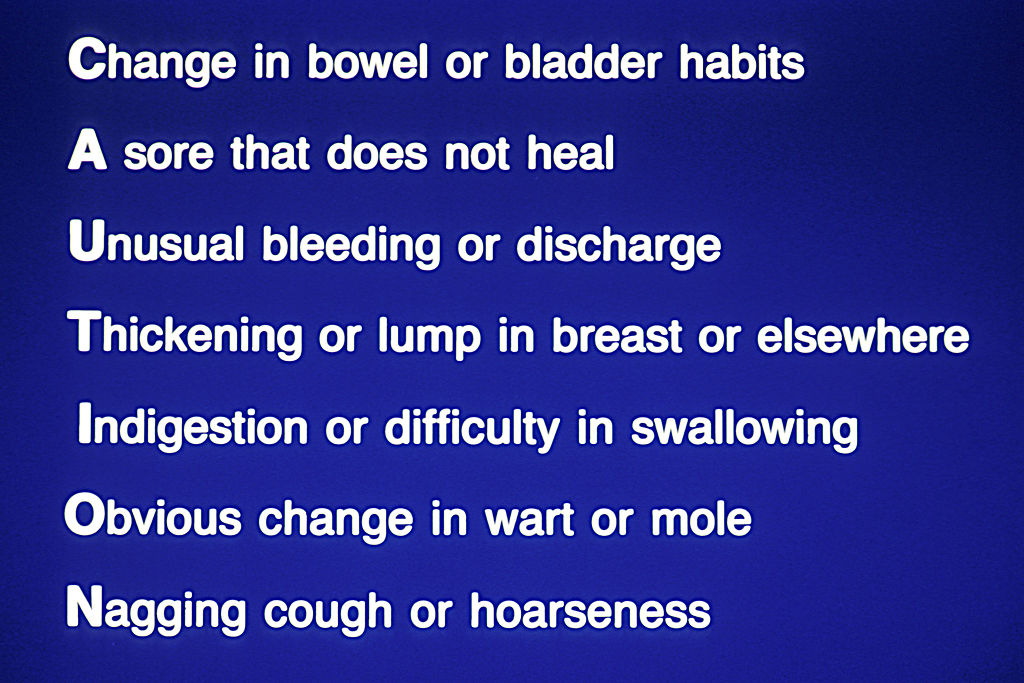
Symptoms as related to type of cancer include:
Lung and bronchus
- Coughing that gets worse or doesn’t go away.
- Chest pain.
- Shortness of breath.
- Wheezing.
- Coughing up blood.
- Feeling very tired all the time.
- Weight loss with no known cause.
Breast (female)
- New lump in the breast or underarm (armpit).
- Thickening or swelling of part of the breast.
- Irritation or dimpling of breast skin.
- Redness or flaky skin in the nipple area or the breast.
- Pulling in of the nipple or pain in the nipple area.
- Nipple discharge other than breast milk, including blood.
- Any change in the size or the shape of the breast.
- Pain in any area of the breast.
Prostate
- Difficulty starting urination.
- Weak or interrupted flow of urine.
- Frequent urination, especially at night.
- Difficulty emptying the bladder completely.
- Pain or burning during urination.
- Blood in the urine or semen.
- Pain in the back, hips, or pelvis that doesn’t go away.
- Painful ejaculation.
Colorectal
- A change in bowel habits.
- Blood in or on your stool (bowel movement).
- Diarrhea, constipation, or feeling that the bowel does not empty all the way.
- Abdominal pain, aches, or cramps that don’t go away.
- Weight loss and you don’t know why.
Pancreas
- often asymptomatic
- jaundice
- Abdominal or back pain.
- nausea and vomiting.
- weight loss or poor appetite.
Liver
- Discomfort in the upper abdomen on the right side.
- A swollen abdomen.
- A hard lump on the right side just below the rib cage.
- Pain near the right shoulder blade or in the back.
- Jaundice (yellowing of the skin and whites of the eyes).
- Easy bruising or bleeding.
- Unusual tiredness.
- Nausea and vomiting.
- Loss of appetite.
- Weight loss for no known reason.
Ovary
- Vaginal bleeding (particularly if you are past menopause), or discharge from your vagina that is not normal for you.
- Pain or pressure in the pelvic area.
- Abdominal or back pain.
- Bloating.
- Feeling full too quickly, or difficulty eating.
- A change in your bathroom habits, such as more frequent or urgent need to urinate and/or constipation.
Leukemia
- Feeling tired (fatigue)
- Feeling weak
- Feeling cold
- Feeling dizzy or lightheaded
- Shortness of breath
- Paler skin
Non-Hodgkin lymphoma
- swollen lymph nodes, especially in the part of
- fever
- night sweats
- feeling tired
- weight loss.
Uterine
- Vaginal bleeding, or discharge from your vagina that is not normal for you.
- Pain or pressure in the pelvic area.
Brain and other nervous system
- Brain tumor symptoms can include:
- Morning headache or headache that goes away after vomiting
- Seizures
- Vision, hearing, and speech problems
- Loss of appetite
- Frequent nausea and vomiting
- Changes in personality, mood, ability to focus, or behavior
- Weakness, loss of balance, and trouble walking
- Unusual sleepiness
- Spinal cord tumor symptoms can include:
- Back pain or pain that spreads from the back towards the arms or legs
- A change in bowel habits or trouble urinating
- Weakness or numbness in the arms or legs
- Trouble walking
Urinary bladder
- Blood in the urine. This is the most common symptom.
- Having to urinate often.
- Pain while urinating.
- Back pain.
- Pelvic pain.
Esophagus
- Trouble swallowing
- Chest pain
- Weight loss
- Hoarseness
- Chronic cough
- Vomiting
- Bone pain (if cancer has spread to the bone)
Kidney and renal pelvis
- Blood in the urine.
- A lump or swelling in the kidney area or abdomen.
- Lower back pain or pain in the side that doesn’t go away.
- Feeling tired often.
- Fever that keeps coming back.
- Not feeling like eating.
- Losing weight for no reason that you know of.
- Something blocking your bowels.
- A general feeling of poor health.
Myeloma
- Commonly asymptomatic
- Bone pain, especially in the back or ribs
- Bones that break easily
- Fever for no known reason;
- Frequent infections; bruising or bleeding easily
- Trouble breathing;
- Weakness of the arms or legs
- Feeling very tired.
Stomach
- Commonly asymptomatic
- Poor appetite
- Weight loss (without trying)
- Abdominal (belly) pain
- Vague discomfort in the abdomen, usually above the navel
- Feeling full after eating only a small meal
- Heartburn or indigestion
- Nausea
- Vomiting, with or without blood
- Swelling or fluid build-up in the abdomen
- Blood in the stool
- Feeling tired or weak, as a result of having too few red blood cells (anemia)
- Yellowing of the skin and eyes (jaundice), if the cancer spreads to the liver
Oral cavity and pharynx
- A white or red sore that does not heal on the gums, tongue, or lining of the mouth.
- Swelling in the jaw.
- Unusual bleeding or pain in the mouth.
- A lump or thickening.
- Problems with dentures.
- Trouble breathing or speaking.
- A lump or thickening.
- Trouble chewing or swallowing food.
- A feeling that something is caught in the throat.
- Pain in the throat that won’t go away.
- Pain or ringing in the ears or trouble hearing.
Cervix
- Vaginal bleeding, or discharge from your vagina that is not normal for you.
Melanoma of the skin
- A-B-C-D-Es of melanoma
- Asymmetrical: Does the mole or spot have an irregular shape with two parts that look very different?
- Border: Is the border irregular or jagged?
- Color: Is the color uneven?
- Diameter: Is the mole or spot larger than the size of a pea?
- Evolving: Has the mole or spot changed during the past few weeks or months?
Larynx
- Pain when swallowing.
- Ear pain.
Thyroid
- A lump or swelling on the side of the neck is the most common symptom.
- Having trouble breathing.
- Having trouble swallowing.
- Having a hoarse voice.
Testis
- A lump or enlargement in either testicle
- A feeling of heaviness in the scrotum
- A dull ache in the abdomen or groin
- A sudden collection of fluid in the scrotum
- Pain or discomfort in a testicle or the scrotum
- Enlargement or tenderness of the breasts
- Back pain
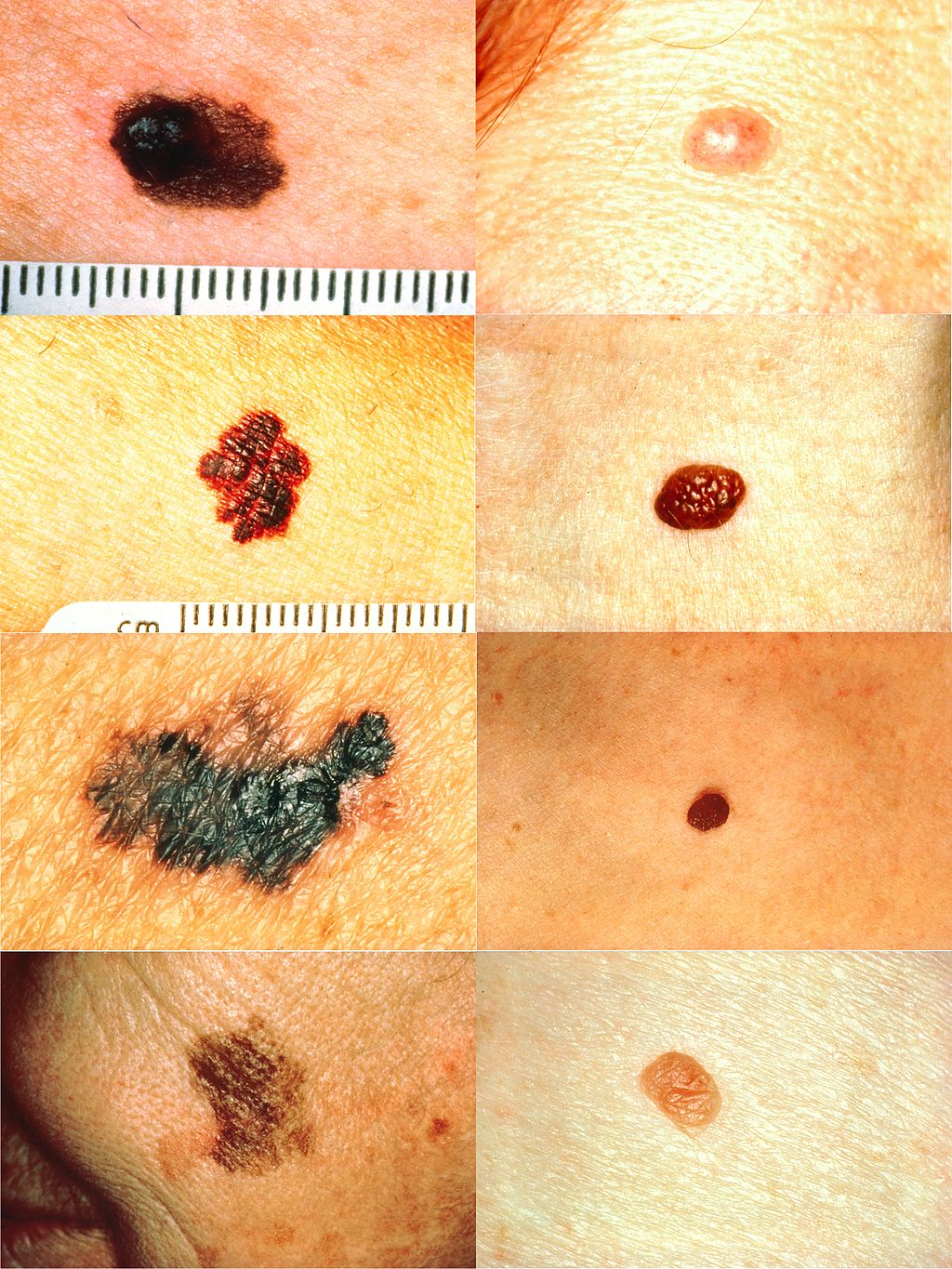
Cancer Risk and Prevention
Cancer prevention are actions you can take to lower the chance of getting cancer. It is usually not possible to know exactly why one person develops cancer and another doesn’t. But research has shown that certain risk factors may increase a person’s chances of developing cancer. Understanding the risk factors can help you to make lifestyle choices to try to prevent or lower your risk of cancer.
- Age
- Advancing age is the most important risk factor for cancer overall and for many individual cancer types. The incidence rates for cancer overall climb steadily as age increases, from fewer than 25 cases per 100,000 people in age groups under age 20, to about 350 per 100,000 people among those aged 45–49, to more than 1,000 per 100,000 people in age groups 60 years and older.
- Alcohol
- Drinking alcohol can increase your risk of cancer of the mouth, throat, esophagus, larynx (voice box), liver, and breast. The more you drink, the higher your risk. The risk of cancer is much higher for those who drink alcohol and also use tobacco.
- Environmental Carcinogens
- People can avoid some cancer-causing exposures, such as tobacco smoke and the sun’s rays. But other ones are harder to avoid, especially if they are in the air we breathe, the water we drink, the food we eat, or the materials we use to do our jobs. Being exposed to chemicals and other substances in the environment has been linked to some cancers. A few carcinogens in our environment include: Arsenic, formaldehyde, asbestos, radon, wood dust, mineral oils, and soot.
- Chronic Inflammation
- In chronic inflammation, the inflammatory process may begin even if there is no injury, and it does not end when it should. Why the inflammation continues is not always known. Chronic inflammation may be caused by infections that don’t go away, abnormal immune reactions to normal tissues, or conditions such as obesity. Over time, chronic inflammation can cause DNA damage and lead to cancer.
- Diet
- Many studies have looked at the possibility that specific dietary components or nutrients are associated with increases or decreases in cancer risk, however results have been inconclusive or need further research. It is hard to study the effects of diet on cancer because a person’s diet includes foods that may protect against cancer and foods that may increase the risk of cancer. Although the research is inconclusive, dietary relations to cancer have included:
- Antioxidants may lower cancer risk by blocking the activity of free radicals that damage cells.
- Artificial sweeteners have been shown to cause bladder cancer in animals.
- Higher intakes of calcium and may reduce risks of colorectal cancer.
- Charred meat increases exposure to chemicals that can cause cancer in animals.
- Red meat is associated with an increased risk of colon and rectum cancer.
- Cruciferous vegetables may have anticancer effects.
- Fluoridated water helps decrease tooth decay, but may increase cancer risk.
- Tea may lower cancer risk by blocking the activity of free radicals that damage cells.
- Higher intakes of vitamin D or higher levels of vitamin D in the blood may be associated with a reduced risk of colorectal cancer.
- Many studies have looked at the possibility that specific dietary components or nutrients are associated with increases or decreases in cancer risk, however results have been inconclusive or need further research. It is hard to study the effects of diet on cancer because a person’s diet includes foods that may protect against cancer and foods that may increase the risk of cancer. Although the research is inconclusive, dietary relations to cancer have included:
- Hormones
- Estrogens, a group of female sex hormones, are known human carcinogens. Although these hormones have essential physiological roles in both females and males, they have also been associated with an increased risk of certain cancers.
- Immunosuppression
- Many people who receive organ transplants take medications to suppress the immune system so the body won’t reject the organ. These “immunosuppressive” drugs make the immune system less able to detect and destroy cancer cells or fight off infections that cause cancer.
- Infectious Agents
- Certain infectious agents, including viruses, bacteria, and parasites, can cause cancer or increase the risk that cancer will form.
- Obesity
- People with obesity may have an increased risk of several types of cancer, including cancers of the breast (in women who have been through menopause), colon, rectum, endometrium (lining of the uterus), esophagus, kidney, pancreas, and gallbladder.
- Radiation
- Radiation of certain wavelengths, called ionizing radiation, has enough energy to damage DNA and cause cancer.
- Sunlight
- The sun, sunlamps, and tanning booths all give off ultraviolet (UV) radiation. Exposure to UV radiation causes early aging of the skin and damage that can lead to skin cancer.
- Tobacco
- Tobacco use is a leading cause of cancer and of death from cancer. Cigarette smoking is the number one risk factor for lung cancer. In the United States, cigarette smoking is linked to about 80% to 90% of lung cancer deaths. People who smoke cigarettes are 15 to 30 times more likely to get lung cancer or die from lung cancer than people who do not smoke.
- Physical activity
- Studies show that people who are physically active have a lower risk of certain cancers than those who are not. It is not known if physical activity itself is the reason for this.
- Diabetes
- Some studies show that having diabetes may slightly increase the risk of having several different types of cancer.
Key Takeaways for Chapter
- Cancer starts with the change in one cell in the body.
- Cancer cells do not like each other and break off from the other cells to spread throughout the body, called Metastasis.
- A cancerous tumor is called malignant, a non-cancerous tumor is called benign.
- Cancer is the 2nd leading cause of death.
- Many cancers are asymptomatic.
- The acronym CAUTION is helpful for remembering some common cancer symptoms.
- Lifestyle choices can impact your risk of getting cancer.
Media Attributions
- Diagram showing how cancer cells keep on reproducing to form a tumour © Cancer Research UK is licensed under a CC BY-SA (Attribution ShareAlike) license
- Diagram showing a tumour forcing its way through normal tissues © Cancer Research UK is licensed under a CC BY-SA (Attribution ShareAlike) license
- Tumor_Types_MTK © WolfpackBME is licensed under a CC BY-SA (Attribution ShareAlike) license
- How_metastasis_occurs_illustration © Unknown Illustrator is licensed under a Public Domain license
- Cancer_warning_signs © Linda Bartlett (Photographer) is licensed under a Public Domain license
- Melanoma_vs_normal_mole_ABCD_rule_NCI_Visuals_Online © Unknown creator; six images merged by User:Stevenfruitsmaak is licensed under a Public Domain license
